Peperomia plant: Varieties, Benefits, and How to Care Guide
Have you been looking for an ornamental plant to improve the aesthetics of your home? A Peperomia plant would be an ideal choice. With so many vining and upright varieties to choose from, you might just find your ideal plant. The plant is also pet-friendly and you don’t have to worry about your pets’ safety. If you have been longing to add your nature-loving personality to your home, you should consider growing a Peperomia plant. Keep reading to find out more.
What is Peperomia?
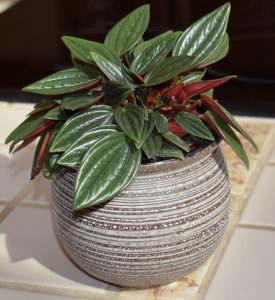
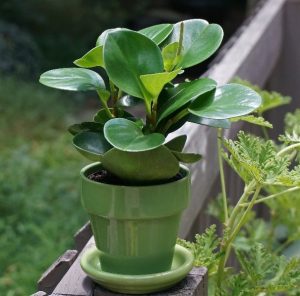
Peperomia is a tropical semi-succulent plant that originates from Mexico, the Caribbean, and South America. The Peperomia plant is also known as the Radiator plant. This plant is low-maintenance making it suitable for beginners.
The Peperomia genus comprises several plant varieties that you can select from based on your preference. Peperomia plants have different shapes, sizes, textures, and colors. One plant might look entirely different from the next.
The leaves of a Peperomia plant can be smooth or textured with different colors ranging from gray, red, purple, green, and more. Most Peperomia plant varieties are slow-growing flowering plants.
A Peperomia plant will accentuate your home and add splendor with its attractive foliage. This plant is also pet-friendly and you can keep your cat or dog around it without worrying.
Benefits of Peperomia plants
You can get several benefits from growing a Peperomia plant. These benefits include:
Health benefits
The Peperomia plant has several health benefits and is used to reduce inflammation in skin wounds and boils. The plant has several other health benefits like treating arthritis, reducing pain, and others.
Purifies the air
According to a study carried out by NASA, the Peperomia plant can purify the air. This plant removes toxins from the air and reduces the level of a toxic substance called Formaldehyde indoors by about 47%.
Peperomia Varieties
There are different Peperomia plant types you can consider when selecting a suitable houseplant. Different types of Peperomia plants have varying characteristics and appearances. Below are several Peperomia varieties with pictures.
Baby Rubber Plant (Peperomia obtusifolia)
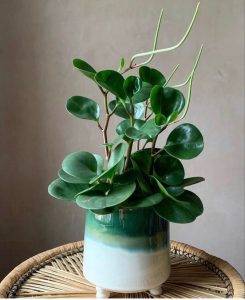
The Baby Rubber plant is also known as Peperomia Frost. This plant has small glossy round leaves. Some Peperomia plants in this variety are variegated while others have a solid green color. The Baby Rubber plant requires adequate lighting to maintain its rich colors. This plant has an upright growth habit and can grow up to 12 inches tall.
Watermelon Peperomia (Peperomia argyreia)
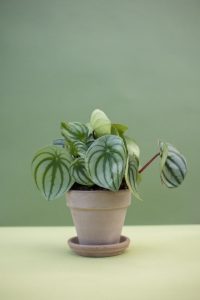
The Watermelon Peperomia is one of the most attractive Peperomia varieties that you can grow indoors. This large leaf Peperomia has green heart-shaped leaves with silvery-white stripes that make the plant resemble a watermelon’s appearance. If you are looking for an ornamental plant that grows upright, the Watermelon Peperomia would be an ideal choice
Trailing Jade Peperomia (Peperomia rotundifolia)
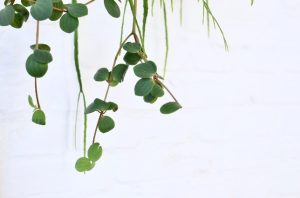
If you are fond of trailing houseplants, the Trailing Jade Peperomia would be a perfect fit for you. This plant has small round glossy leaves. The plant’s leaves are fleshy resembling those of a succulent. You can plant your Trailing Jade Peperomia in a hanging basket and watch how it accentuates your interior décor.
Raindrop Peperomia (Peperomia polybotrya)

The Raindrop Peperomia is a unique Peperomia variety that makes a bold statement in any room it occupies. This plant has small glossy heart-shaped leaves that resemble raindrops. The plant’s leaves have a rich green color that enhances the aesthetic appeal of your home. This plant grows upright and can reach up to 12 inches tall.
String of Turtles Peperomia (Peperomia prostrata)
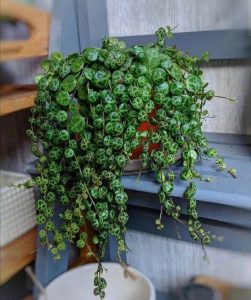
The String of Turtle Peperomia is a distinctive plant that would make a great indoor plant addition. This plant has small round leaves that resemble turtle shells. The plant’s leaves can be variegated or solid-green. The String of Turtles plant is a vining variety and would be suitable for hanging baskets.
Piper Peperomia (Peperomia scandens)
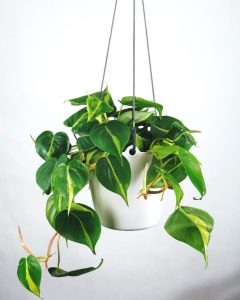
Also known as the Cupid Peperomia, Peperomia Scadens is an attractive Peperomia variety that adds a pop of color to your home. This plant has thick, shiny heart-shaped leaves that can be variegated or solid green. The plant has a trailing growth habit and would look perfect in a hanging basket.
Peperomia pepperspot (Peperomia protrasta Pepperspot)
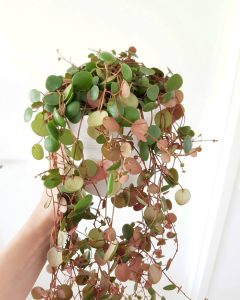
This plant is also known as the String of Coins and has very unique foliage. The plant has small fleshy green leaves with red stems. This vining plant grows slowly and is ideal for small spaces. You can grow your Peperomia Pepperspot in a hanging basket.
Peperomia Ginny (Peperomia clusiifolia)
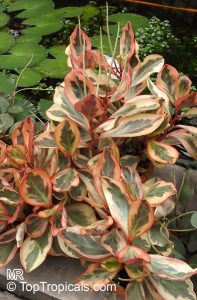
The Peperomia Ginny otherwise known as Peperomia Jelly is a multicolored Peperomia variety that adds vibrancy to your home. This plant has long variegated leaves with different colors including red, green, pink, and cream.
Peperomia Ruby Cascade
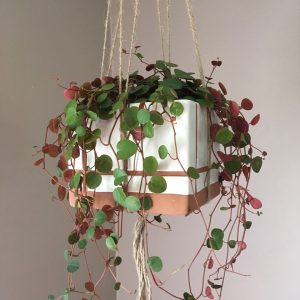
The Peperomia Ruby Cascade is a trailing Peperomia variety that you can grow indoors. This plant features oval leaves that can be green or purple and a ruby-red stem. This plant can grow up to 12 inches and would be perfect for a hanging basket.
Peperomia Happy Bean (Peperomia ferreyrae)
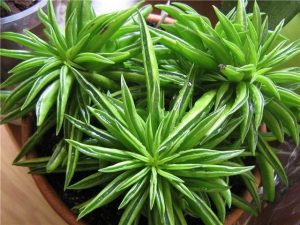
The Peperomia Happy Bean, also known as the Pincushion Peperomia is one of the most unique Peperomia varieties with distinctive foliage. The plant has long fleshy peapod-shaped green leaves that grow in clusters giving the plant a bushy appearance.
Teardrop Peperomia (Peperomia orba)
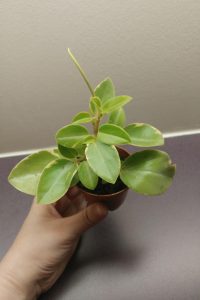
The Teardrop Peperomia is a popular indoor plant with attractive foliage. Different varieties of Teardrop Peperomia have varying colors. Some have green leaves with yellow margins while others have lime-green leaves.
How to care for a Peperomia plant
Peperomia plants are low-maintenance and suitable for beginners. Nevertheless, you should take care of your Peperomia plant to ensure it thrives. Learn how to care for your plant below.
Peperomia plant sunlight
Your Peperomia plant will flourish in bright to medium indirect sunlight. When provided with adequate lighting, your plant will maintain its solid or variegated colors. Exposing your plant to direct sunlight will scorch its leaves. On the other hand, without adequate lighting, your plant will become stretchy and begin losing its leaves. Try to strike a balance to achieve maximum growth.
Peperomia plant water
Most Peperomia varieties have succulent leaves and don’t require regular watering. Water your plant when the soil is partially dry. The ideal time to water your plant is after 1 to 2 weeks.
Your plant’s leaves will begin to lose their thickness when underwatered. You might water your plant more frequently during the summer than during the winter season. Be careful not to overwater your plant. Doing so will quickly kill your plant due to root rot.
Peperomia plant soil type
Peperomia plants prefer well-draining soil to remain healthy. Plant your Peperomia in loose soil that drains easily to prevent waterlogging. You can use all-purpose potting soil and add sand and perlite to improve drainage.
Peperomia humidity and temperature
Peperomia plants are tropical plants and they require warm and humid conditions to flourish. The ideal temperature range is between 65 and 75 degrees. Your Peperomia plant will do just fine in room temperature conditions. Don’t expose your plant to freezing temperatures.
To increase humidity, regularly mist your plant. Alternatively, you can use a humidifier or place your plant in a humidity tray. To avoid fungal issues, mist your plant in the morning to give your leaves enough time to dry up.
Peperomia fertilizer
Most Peperomias are slow-growing plants and they don’t require feeding to survive. However, you can occasionally use a balanced fertilizer to feed your plant. Too much fertilizer will damage the plant’s roots and leaves.
Peperomia repotting
Since Peperomias are slow-growing plants, there is no need to regularly re-pot them. Re-pot your plant when you see roots protruding from the pot’s drainage holes. When re-potting your plant, use a slightly larger pot. An oversized pot might lead to waterlogging.
Peperomia pruning
You want to keep your plant looking its best. You can do that with occasional pruning to get rid of damaged leaves and stems.
Propagating Peperomia
You can propagate a new Peperomia plant from the original plant using the following steps.
- Cut off a leaf along with a stem
- Plant the cutting in a pot with well-draining soil
- Place your cutting near a light source and cover it with a plastic wrap
- Water your cutting regularly without letting the soil dry out
- After a while your stem cutting will develop roots
Peperomia toxicity
As the saying goes “curiosity killed the cat”. However, with Peperomia, you don’t have to worry about any dead cats. Your pets will be safe around your plant. Despite being a non-toxic plant, you don’t want your pets destroying your beautiful plant and we recommend keeping it out of reach.
Indoor plant enthusiasts grow Peperomia plants for their unique foliage. Most Peperomia plants are low-maintenance sustainable plants that complement almost any kind of décor. The plants’ air-purifying abilities place them on the best bedroom plant list and you don’t have to interrupt your sleep pattern due to constant allergies. You can easily buy your houseplant online and enjoy the benefits that follow. For more information, get in touch with us today.
